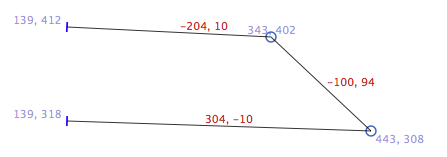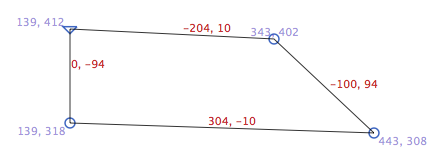It is a tricky topic.
Technically, all paths must be (and are assumed) closed in an OTF. Thing is, practically every interpreter implies a closepath instruction at the end of a charstring. A charstring is the literal definition of the glyph. One example in TTX code:
600 139 318 rmoveto 304 -10 -100 94 -204 10 rlineto endcharThe first line defines the width of the glyph as 600 units, then moves the first point of the path to x=138, y=318. rmoveto means “relative move-to”. A “move-to” instruction indicates the start of a path. The second line draws three lines with rlineto (relative line-to): (1.) from x=138, y=318 (this is where we left of at the “move-to”) 304 units to the right, and 10 down; (2.) then 100 to the left and 94 up; (3.) then 204 to the left and 10 up. Finally, the endchar instruction says this glyph is finished.
This is what it looks like in Glyphs:
You see, there is no closing (fourth) line defined. The third line ends somewhere above the originating point. Now here’s the deal: Almost every rasterizer or interpreter that finds this glyph will assume an implicit closing line from the final line-to point to the originating move-to point. That means that the same charstring will look like this when displayed:
The point is that Glyphs can differentiate between those two, while OpenType cannot. And Glyphs will keep the open path if the Remove Overlap option is not ticked off at Export. Thus, we can control which lines are explicitly defined. And this is all we need for the plotter. Because the plotter, by its very nature, does not implicitly assume that closing line I mentioned above.
I hope this clears up any confusion.

